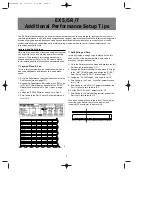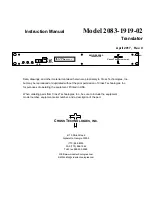
Us
ing MIDI
11
Note On/Off — specifies which keys are
pressed (Note On) or released (Note Off).
Also includes how loud a note is played as a
value from 0 to 127.
±
Program Change — specifies the tone. The
keyboard sends program change data in the
range of 0 to 99, corresponding to tone
numbers. It receives data within the same
range if GM tone mapping is set to N, or in
the range of 0 to 127 if GM tone mapping is
set to G. In the latter case, tones in the
range of 100 to 127 are translated to the
closest tone that the keyboard has.
Pitch Bend — supplies Pitch Bend
information. The keyboard’s pitch changes
as it receives a Pitch Bend message
through the
MIDI IN
terminal.
Control Change — adds effects such as
vibrato and volume changes during
keyboard play. The message includes a
control number (the effect type) and a
control value (the on/off and depth of the
effect).
Here is the data that can be received with
this keyboard and the corresponding control
number.
The keyboard can send Hold1 Control
Change data only when you connect a
sustain pedal and press it.
%
*#0)+0)
"
/+&+
"
5
'66+0)5
The keyboard lets you change two MIDI
parameters, Tone Map and Keyboard
Channel.
Tone Map —sets the range of program
change values received/recognized by this
keyboard.
1. Repeatedly press
TRANSPOSE/TUNE/
MIDI
until
JedCWf3D
JedCWf3D
JedCWf3D
JedCWf3D
appears.
2. Within 5 seconds, press – or + to select
the setting you want.
DDDD
: Normal Tone Map. This setting allows
receipt of 0 to 99 program changes.
Each program change corresponds to
one of the prerecorded tones.
====
: General MIDI Tone Map. This setting
allows receipt of all 0 to 127 program
changes. Any data over 100 are
translated to the closest tone the
keyboard has. See “Note Table” on
Page 15 for details.
Select
====
when you listen to General
MIDI data from an external device.
Keyboard Channel — sets the channel for
sending MIDI data to an external device
(Default: 01). The keyboard receives MIDI
data on channels 1 through 4 and 10 only. The
data received on other channels are ignored.
For transmission of MIDI data, you can use
any of 16 channels.
1. Repeatedly press
TRANSPOSE/TUNE/
MIDI
until
A[oXZý9^
A[oXZý9^
A[oXZý9^
A[oXZý9^
appears.
2. Within 5 seconds, press – or + to select
the channel you want.
0
16'5
"
#
$176
"
6*'
"
/+&+
"
+
/2.'/'06#6+10
"
%
*#46
The “MIDI Implementation Chart” on
Page 17 shows specific details about how
your keyboard is compatible with the MIDI
standard. The following notes explain how
the keyboard works within the MIDI
standard.
Basic Channel — The MIDI standard
allows for the use of up to 16 channels to
exchange data. Like a TV broadcast, each
of these channels can contain different data.
The keyboard can send data on all 16 of
these channels and can receive data on
channels 1 through 4 and channel 10.
Mode — The MIDI standard allows for four
separate modes of operation. The keyboard
sends and receives data in Mode 3. This
means that the data sent and received by
the keyboard can be polyphonic and can be
sent or received on only one channel at a
time.
Note Number — The MIDI standard allows
for note numbers from 0 through 127. This
number represents each possible note that
a device can play. The lowest note number
(0) is five octaves below middle C and the
highest note number (127) is three octaves
above middle C. The keyboard can receive
all 128 note numbers and can send note
numbers between 36 and 96.
If the keyboard receives a note number
outside its range, it automatically assigns
the note to a key within its key range.
The keyboard’s lowest note is two octaves
below middle C, and the highest note is
three octaves above middle C.
Velocity — The MIDI standard allows for
velocity numbers from 0 through 127.
Velocity is how fast a key is pressed (or if
the key is pressed at all) or how loud a note
sounds. A velocity of 0 means that the key is
not pressed. The lowest velocity (1) is
pianissimo and the highest velocity (127) is
fortissimo. The keyboard can receive all 128
velocity numbers and can send velocity
numbers 75 or 100.
9
n — This means that the Note ON
message is 9 hexadecimal for the channel
number
n.
'HHGEV
%QPVTQN
"
0WODGT
Modulation
1
Volume
7
Hold1 (Sustain)
64
±
"
016'
"
±
"
•
The pitch of a note depends on the tone
that is being used, as shown in the “Note
Table” on Page 15.
•
If the keyboard receives a “request” to play
notes outside of its range (higher or lower),
it automatically selects the same note in the
nearest octave.
42-4056.fm Page 11 Friday, April 26, 2002 9:14 AM






































